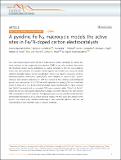A pyridinic Fe-N4 macrocycle models the active sites in Fe/N-doped carbon electrocatalysts
Author(s)
Marshall-Roth, Travis; Libretto, Nicole J; Wrobel, Alexandra T; Anderton, Kevin J; Pegis, Michael L; Ricke, Nathan D; Voorhis, Troy Van; Miller, Jeffrey T; Surendranath, Yogesh; ... Show more Show less
DownloadPublished version (1.167Mb)
Publisher with Creative Commons License
Publisher with Creative Commons License
Creative Commons Attribution
Terms of use
Metadata
Show full item recordAbstract
© 2020, The Author(s). Iron- and nitrogen-doped carbon (Fe-N-C) materials are leading candidates to replace platinum catalysts for the oxygen reduction reaction (ORR) in fuel cells; however, their active site structures remain poorly understood. A leading postulate is that the iron-containing active sites exist primarily in a pyridinic Fe-N4 ligation environment, yet, molecular model catalysts generally feature pyrrolic coordination. Herein, we report a molecular pyridinic hexaazacyclophane macrocycle, (phen2N2)Fe, and compare its spectroscopic, electrochemical, and catalytic properties for ORR to a typical Fe-N-C material and prototypical pyrrolic iron macrocycles. N 1s XPS and XAS signatures for (phen2N2)Fe are remarkably similar to those of Fe-N-C. Electrochemical studies reveal that (phen2N2)Fe has a relatively high Fe(III/II) potential with a correlated ORR onset potential within 150 mV of Fe-N-C. Unlike the pyrrolic macrocycles, (phen2N2)Fe displays excellent selectivity for four-electron ORR, comparable to Fe-N-C materials. The aggregate spectroscopic and electrochemical data demonstrate that (phen2N2)Fe is a more effective model of Fe-N-C active sites relative to the pyrrolic iron macrocycles, thereby establishing a new molecular platform that can aid understanding of this important class of catalytic materials.
Date issued
2020Department
Massachusetts Institute of Technology. Department of ChemistryJournal
Nature Communications
Publisher
Springer Science and Business Media LLC
Citation
Marshall-Roth, Travis, Libretto, Nicole J, Wrobel, Alexandra T, Anderton, Kevin J, Pegis, Michael L et al. 2020. "A pyridinic Fe-N4 macrocycle models the active sites in Fe/N-doped carbon electrocatalysts." Nature Communications, 11 (1).
Version: Final published version